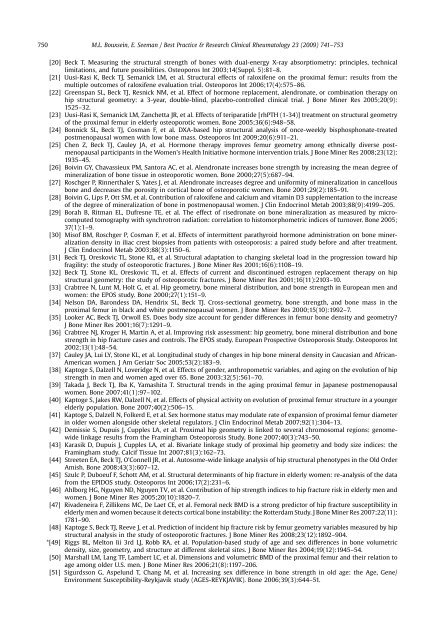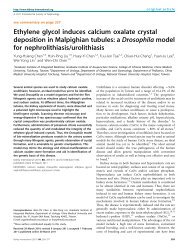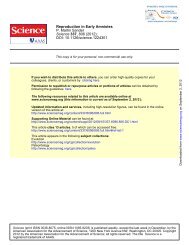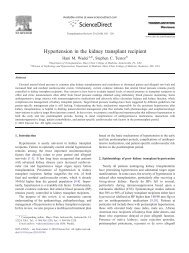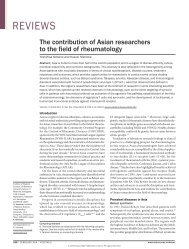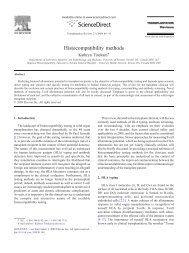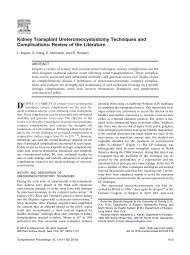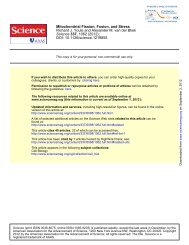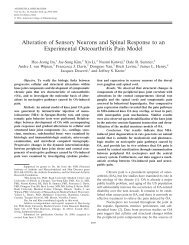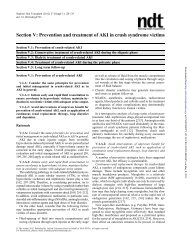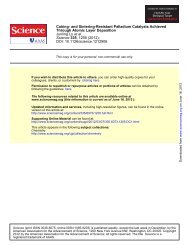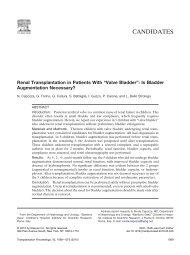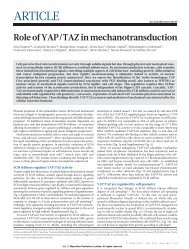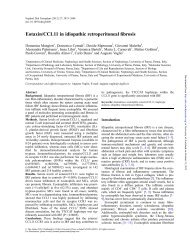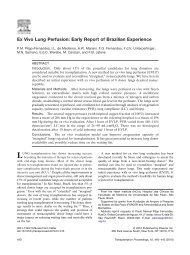Quantifying the material and structural determinants of bone strength
Quantifying the material and structural determinants of bone strength
Quantifying the material and structural determinants of bone strength
Create successful ePaper yourself
Turn your PDF publications into a flip-book with our unique Google optimized e-Paper software.
750<br />
M.L. Bouxsein, E. Seeman / Best Practice & Research Clinical Rheumatology 23 (2009) 741–753<br />
[20] Beck T. Measuring <strong>the</strong> <strong>structural</strong> <strong>strength</strong> <strong>of</strong> <strong>bone</strong>s with dual-energy X-ray absorptiometry: principles, technical<br />
limitations, <strong>and</strong> future possibilities. Osteoporos Int 2003;14(Suppl. 5):81–8.<br />
[21] Uusi-Rasi K, Beck TJ, Semanick LM, et al. Structural effects <strong>of</strong> raloxifene on <strong>the</strong> proximal femur: results from <strong>the</strong><br />
multiple outcomes <strong>of</strong> raloxifene evaluation trial. Osteoporos Int 2006;17(4):575–86.<br />
[22] Greenspan SL, Beck TJ, Resnick NM, et al. Effect <strong>of</strong> hormone replacement, alendronate, or combination <strong>the</strong>rapy on<br />
hip <strong>structural</strong> geometry: a 3-year, double-blind, placebo-controlled clinical trial. J Bone Miner Res 2005;20(9):<br />
1525–32.<br />
[23] Uusi-Rasi K, Semanick LM, Zanchetta JR, et al. Effects <strong>of</strong> teriparatide [rhPTH (1-34)] treatment on <strong>structural</strong> geometry<br />
<strong>of</strong> <strong>the</strong> proximal femur in elderly osteoporotic women. Bone 2005;36(6):948–58.<br />
[24] Bonnick SL, Beck TJ, Cosman F, et al. DXA-based hip <strong>structural</strong> analysis <strong>of</strong> once-weekly bisphosphonate-treated<br />
postmenopausal women with low <strong>bone</strong> mass. Osteoporos Int 2009;20(6):911–21.<br />
[25] Chen Z, Beck TJ, Cauley JA, et al. Hormone <strong>the</strong>rapy improves femur geometry among ethnically diverse postmenopausal<br />
participants in <strong>the</strong> Women’s Health Initiative hormone intervention trials. J Bone Miner Res 2008;23(12):<br />
1935–45.<br />
[26] Boivin GY, Chavassieux PM, Santora AC, et al. Alendronate increases <strong>bone</strong> <strong>strength</strong> by increasing <strong>the</strong> mean degree <strong>of</strong><br />
mineralization <strong>of</strong> <strong>bone</strong> tissue in osteoporotic women. Bone 2000;27(5):687–94.<br />
[27] Roschger P, Rinnerthaler S, Yates J, et al. Alendronate increases degree <strong>and</strong> uniformity <strong>of</strong> mineralization in cancellous<br />
<strong>bone</strong> <strong>and</strong> decreases <strong>the</strong> porosity in cortical <strong>bone</strong> <strong>of</strong> osteoporotic women. Bone 2001;29(2):185–91.<br />
[28] Boivin G, Lips P, Ott SM, et al. Contribution <strong>of</strong> raloxifene <strong>and</strong> calcium <strong>and</strong> vitamin D3 supplementation to <strong>the</strong> increase<br />
<strong>of</strong> <strong>the</strong> degree <strong>of</strong> mineralization <strong>of</strong> <strong>bone</strong> in postmenopausal women. J Clin Endocrinol Metab 2003;88(9):4199–205.<br />
[29] Borah B, Ritman EL, Dufresne TE, et al. The effect <strong>of</strong> risedronate on <strong>bone</strong> mineralization as measured by microcomputed<br />
tomography with synchrotron radiation: correlation to histomorphometric indices <strong>of</strong> turnover. Bone 2005;<br />
37(1):1–9.<br />
[30] Mis<strong>of</strong> BM, Roschger P, Cosman F, et al. Effects <strong>of</strong> intermittent parathyroid hormone administration on <strong>bone</strong> mineralization<br />
density in iliac crest biopsies from patients with osteoporosis: a paired study before <strong>and</strong> after treatment.<br />
J Clin Endocrinol Metab 2003;88(3):1150–6.<br />
[31] Beck TJ, Oreskovic TL, Stone KL, et al. Structural adaptation to changing skeletal load in <strong>the</strong> progression toward hip<br />
fragility: <strong>the</strong> study <strong>of</strong> osteoporotic fractures. J Bone Miner Res 2001;16(6):1108–19.<br />
[32] Beck TJ, Stone KL, Oreskovic TL, et al. Effects <strong>of</strong> current <strong>and</strong> discontinued estrogen replacement <strong>the</strong>rapy on hip<br />
<strong>structural</strong> geometry: <strong>the</strong> study <strong>of</strong> osteoporotic fractures. J Bone Miner Res 2001;16(11):2103–10.<br />
[33] Crabtree N, Lunt M, Holt G, et al. Hip geometry, <strong>bone</strong> mineral distribution, <strong>and</strong> <strong>bone</strong> <strong>strength</strong> in European men <strong>and</strong><br />
women: <strong>the</strong> EPOS study. Bone 2000;27(1):151–9.<br />
[34] Nelson DA, Barondess DA, Hendrix SL, Beck TJ. Cross-sectional geometry, <strong>bone</strong> <strong>strength</strong>, <strong>and</strong> <strong>bone</strong> mass in <strong>the</strong><br />
proximal femur in black <strong>and</strong> white postmenopausal women. J Bone Miner Res 2000;15(10):1992–7.<br />
[35] Looker AC, Beck TJ, Orwoll ES. Does body size account for gender differences in femur <strong>bone</strong> density <strong>and</strong> geometry?<br />
J Bone Miner Res 2001;16(7):1291–9.<br />
[36] Crabtree NJ, Kroger H, Martin A, et al. Improving risk assessment: hip geometry, <strong>bone</strong> mineral distribution <strong>and</strong> <strong>bone</strong><br />
<strong>strength</strong> in hip fracture cases <strong>and</strong> controls. The EPOS study. European Prospective Osteoporosis Study. Osteoporos Int<br />
2002;13(1):48–54.<br />
[37] Cauley JA, Lui LY, Stone KL, et al. Longitudinal study <strong>of</strong> changes in hip <strong>bone</strong> mineral density in Caucasian <strong>and</strong> African-<br />
American women. J Am Geriatr Soc 2005;53(2):183–9.<br />
[38] Kaptoge S, Dalzell N, Loveridge N, et al. Effects <strong>of</strong> gender, anthropometric variables, <strong>and</strong> aging on <strong>the</strong> evolution <strong>of</strong> hip<br />
<strong>strength</strong> in men <strong>and</strong> women aged over 65. Bone 2003;32(5):561–70.<br />
[39] Takada J, Beck TJ, Iba K, Yamashita T. Structural trends in <strong>the</strong> aging proximal femur in Japanese postmenopausal<br />
women. Bone 2007;41(1):97–102.<br />
[40] Kaptoge S, Jakes RW, Dalzell N, et al. Effects <strong>of</strong> physical activity on evolution <strong>of</strong> proximal femur structure in a younger<br />
elderly population. Bone 2007;40(2):506–15.<br />
[41] Kaptoge S, Dalzell N, Folkerd E, et al. Sex hormone status may modulate rate <strong>of</strong> expansion <strong>of</strong> proximal femur diameter<br />
in older women alongside o<strong>the</strong>r skeletal regulators. J Clin Endocrinol Metab 2007;92(1):304–13.<br />
[42] Demissie S, Dupuis J, Cupples LA, et al. Proximal hip geometry is linked to several chromosomal regions: genomewide<br />
linkage results from <strong>the</strong> Framingham Osteoporosis Study. Bone 2007;40(3):743–50.<br />
[43] Karasik D, Dupuis J, Cupples LA, et al. Bivariate linkage study <strong>of</strong> proximal hip geometry <strong>and</strong> body size indices: <strong>the</strong><br />
Framingham study. Calcif Tissue Int 2007;81(3):162–73.<br />
[44] Streeten EA, Beck TJ, O’Connell JR, et al. Autosome-wide linkage analysis <strong>of</strong> hip <strong>structural</strong> phenotypes in <strong>the</strong> Old Order<br />
Amish. Bone 2008;43(3):607–12.<br />
[45] Szulc P, Duboeuf F, Schott AM, et al. Structural <strong>determinants</strong> <strong>of</strong> hip fracture in elderly women: re-analysis <strong>of</strong> <strong>the</strong> data<br />
from <strong>the</strong> EPIDOS study. Osteoporos Int 2006;17(2):231–6.<br />
[46] Ahlborg HG, Nguyen ND, Nguyen TV, et al. Contribution <strong>of</strong> hip <strong>strength</strong> indices to hip fracture risk in elderly men <strong>and</strong><br />
women. J Bone Miner Res 2005;20(10):1820–7.<br />
[47] Rivadeneira F, Zillikens MC, De Laet CE, et al. Femoral neck BMD is a strong predictor <strong>of</strong> hip fracture susceptibility in<br />
elderly men <strong>and</strong> women because it detects cortical <strong>bone</strong> instability: <strong>the</strong> Rotterdam Study. J Bone Miner Res 2007;22(11):<br />
1781–90.<br />
[48] Kaptoge S, Beck TJ, Reeve J, et al. Prediction <strong>of</strong> incident hip fracture risk by femur geometry variables measured by hip<br />
<strong>structural</strong> analysis in <strong>the</strong> study <strong>of</strong> osteoporotic fractures. J Bone Miner Res 2008;23(12):1892–904.<br />
*[49] Riggs BL, Melton Iii 3rd LJ, Robb RA, et al. Population-based study <strong>of</strong> age <strong>and</strong> sex differences in <strong>bone</strong> volumetric<br />
density, size, geometry, <strong>and</strong> structure at different skeletal sites. J Bone Miner Res 2004;19(12):1945–54.<br />
[50] Marshall LM, Lang TF, Lambert LC, et al. Dimensions <strong>and</strong> volumetric BMD <strong>of</strong> <strong>the</strong> proximal femur <strong>and</strong> <strong>the</strong>ir relation to<br />
age among older U.S. men. J Bone Miner Res 2006;21(8):1197–206.<br />
[51] Sigurdsson G, Aspelund T, Chang M, et al. Increasing sex difference in <strong>bone</strong> <strong>strength</strong> in old age: <strong>the</strong> Age, Gene/<br />
Environment Susceptibility-Reykjavik study (AGES-REYKJAVIK). Bone 2006;39(3):644–51.


